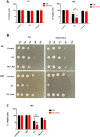The antifungal effect induced by itraconazole in Candida parapsilosis largely depends on the oxidative stress generated at the mitochondria
- PMID: 37119267
- PMCID: PMC10163099
- DOI: 10.1007/s00294-023-01269-z
The antifungal effect induced by itraconazole in Candida parapsilosis largely depends on the oxidative stress generated at the mitochondria
Abstract
In Candida parapsilosis, homozygous disruption of the two genes encoding trehalase activity increased the susceptibility to Itraconazole compared with the isogenic parental strain. The fungicidal effect of this azole can largely be counteracted by preincubating growing cells with rotenone and the protonophore 2,4-Dinitrophenol. In turn, measurement of endogenous reactive oxygen species formation by flow cytometry confirmed that Itraconazole clearly induced an internal oxidative stress, which can be significantly abolished in rotenone-exposed cells. Analysis of the antioxidant enzymatic activities of catalase and superoxide dismutase pointed to a moderate decrease of catalase in trehalase-deficient mutant cells compared to the wild type, with an additional increase upon addition of rotenone. These enzymatic changes were imperceptible in the case of superoxide dismutase. Alternative assays with Voriconazole led to a similar profile in the results regarding cell growth and antioxidant activities. Collectively, our data suggest that the antifungal action of Itraconazole on C. parapsilosis is dependent on a functional mitochondrial activity. They also suggest that the central metabolic pathways in pathogenic fungi should be considered as preferential antifungal targets in new research.
Keywords: Candida parapsilosis; Dinitrophenol; Mitochondria; ROS; Rotenone; Trehalase.
© 2023. The Author(s).
Conflict of interest statement
The authors have not disclosed any competing interests.
Figures




Similar articles
-
Physiological and Transcriptional Responses of Candida parapsilosis to Exogenous Tyrosol.Appl Environ Microbiol. 2019 Oct 1;85(20):e01388-19. doi: 10.1128/AEM.01388-19. Print 2019 Oct 15. Appl Environ Microbiol. 2019. PMID: 31399405 Free PMC article.
-
Lack of Functional Trehalase Activity in Candida parapsilosis Increases Susceptibility to Itraconazole.J Fungi (Basel). 2022 Apr 5;8(4):371. doi: 10.3390/jof8040371. J Fungi (Basel). 2022. PMID: 35448602 Free PMC article.
-
Reactive oxygen species-inducing itraconazole and its anti-biofilm activity against resistant Candida parapsilosis sensu lato biofilm cells isolated from patients with recalcitrant onychomycosis.Arch Dermatol Res. 2024 Sep 26;316(9):642. doi: 10.1007/s00403-024-03382-6. Arch Dermatol Res. 2024. PMID: 39325271
-
Candida and candidaemia. Susceptibility and epidemiology.Dan Med J. 2013 Nov;60(11):B4698. Dan Med J. 2013. PMID: 24192246 Review.
-
Two cases of primary cutaneous candidiasis caused by Candida parapsilosis: a report and literature review.J Mycol Med. 2021 Sep;31(3):101158. doi: 10.1016/j.mycmed.2021.101158. Epub 2021 May 26. J Mycol Med. 2021. PMID: 34147759 Review.
Cited by
-
Reactive oxidant species induced by antifungal drugs: identity, origins, functions, and connection to stress-induced cell death.Front Cell Infect Microbiol. 2023 Oct 12;13:1276406. doi: 10.3389/fcimb.2023.1276406. eCollection 2023. Front Cell Infect Microbiol. 2023. PMID: 37900311 Free PMC article. Review.
-
The Role of Oxidative Stress in the Antifungal Activity of Two Mollusk Fractions on Resistant Fungal Strains.Int J Mol Sci. 2025 Jan 24;26(3):985. doi: 10.3390/ijms26030985. Int J Mol Sci. 2025. PMID: 39940751 Free PMC article.
References
MeSH terms
Substances
LinkOut - more resources
Full Text Sources

